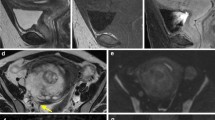Abstract
Gastric-type adenocarcinoma (GAS) of the uterine cervix is a recently defined subtype of mucinous adenocarcinoma. GAS is proposed to include minimal deviation adenocarcinoma (MDA) as a very well-differentiated form and has been suggested to arise from lobular endocervical glandular hyperplasia (LEGH). We report the magnetic resonance imaging (MRI) findings of a GAS associated with LEGH. On MRI, the LEGH component was detected as multiple cystic lesions arranged in a “cosmos pattern”, while the GAS was depicted as a predominantly solid lesion containing obvious adenocarcinoma and MDA components, which appeared as mass-like and infiltrative components, respectively. The GAS exhibited tiny cysts on three-dimensional T2-weighted images, high intensity on diffusion-weighted images mostly due to T2 shine-through effect according to apparent diffusion coefficient (ADC) map, and reticular enhancement on dynamic contrast-enhanced MRI, which reflected numerous dilated glandular structures of the tumor. Low ADC was only observed at the deepest invasion front of the obvious adenocarcinoma component. Our case suggests that the MRI features of GAS vary depending on the tumor’s histological components, and it is important to be aware of these imaging features when evaluating LEGH on MRI.





Similar content being viewed by others
References
Kurman RJ, Carcangiu ML, Herrington CS, Young RH (2014) World Health Organization classification of tumours of female reproductive organs. Lyon: IARC Press
Mikami Y, McCluggage WG (2013) Endocervical glandular lesions exhibiting gastric differentiation: an emerging spectrum of benign, premalignant, and malignant lesions. Adv Anat Pathol 20:227–237
Mikami Y, Kiyokawa T, Hata S, et al. (2004) Gastrointestinal immunophenotype in adenocarcinomas of the uterine cervix and related glandular lesions: a possible link between lobular endocervical glandular hyperplasia/pyloric gland metaplasia and ‘adenoma malignum’. Mod Pathol 17:962–972
Takatsu A, Miyamoto T, Fuseya C, et al. (2013) Clonality analysis suggests that STK11 gene mutations are involved in progression of lobular endocervical glandular hyperplasia (LEGH) to minimal deviation adenocarcinoma (MDA). Virchows Arch 462:645–651
Kojima A, Mikami Y, Sudo T, et al. (2007) Gastric morphology and immunophenotype predict poor outcome in mucinous adenocarcinoma of the uterine cervix. Am J Surg Pathol 31:664–672
Ishii K, Hosaka N, Toki T, et al. (1998) a new view of the so-called adenoma malignum of the uterine cervix. Virchows Arch 432:315–322
Nucci MR, Clement PB, Young RH (1999) Lobular endocervical glandular hyperplasia, not otherwise specified: a clinicopathologic analysis of thirteen cases of a distinctive pseudoneoplastic lesion and comparison with fourteen cases of adenoma malignum. Am J Surg Pathol 23:886–891
Takatsu A, Shiozawa T, Miyamoto T, et al. (2011) Preoperative differential diagnosis of minimal deviation adenocarcinoma and lobular endocervical glandular hyperplasia of the uterine cervix: a multicenter study of clinicopathology and magnetic resonance imaging findings. Int J Gynecol Cancer 21:1287–1296
Tsuji T, Togami S, Nomoto M, et al. (2011) Uterine cervical carcinomas associated with lobular endocervical glandular hyperplasia. Histopathology 59:55–62
McCluggage WG, Harley I, Houghton JP, et al. (2010) Composite cervical adenocarcinoma composed of adenoma malignum and gastric type adenocarcinoma (dedifferentiated adenoma malignum) in a patient with Peutz Jeghers syndrome. J Clin Pathol 63:935–941
Park SB, Lee JH, Lee YH, et al. (2013) Adenoma malignum of the uterine cervix: imaging features with clinicopathologic correlation. Acta Radiol 54:113–120
Doi T, Yamashita Y, Yasunaga T, et al. (1997) Adenoma malignum; MR imaging and pathologic study. Radiology 204:39–42
Chen YB, Hu CM, Chen GL, et al. (2011) Staging of uterine cervical carcinoma: whole-body diffusion-weighted magnetic resonance imaging. Abdom Imaging 36:619–626
Kuang F, Ren J, Zhong Q, et al. (2013) The value of apparent diffusion coefficient in the assessment of cervical cancer. Eur Radiol 23:1050–1058
Author information
Authors and Affiliations
Corresponding author
Rights and permissions
About this article
Cite this article
Tsuboyama, T., Yamamoto, K., Nakai, G. et al. A case of gastric-type adenocarcinoma of the uterine cervix associated with lobular endocervical glandular hyperplasia: radiologic–pathologic correlation. Abdom Imaging 40, 459–465 (2015). https://doi.org/10.1007/s00261-014-0323-6
Published:
Issue Date:
DOI: https://doi.org/10.1007/s00261-014-0323-6




